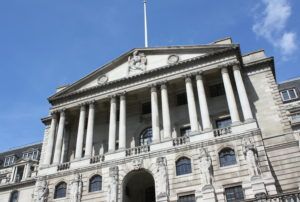While the overall impact of climate change on the insurance industry is difficult to quantify, the multilayered effects of regulation, reputation and litigation will be “considerable” over the long term, Standard & Poor’s said in a report last week.
The report came just days after the shareholders of Berkshire Hathaway voted down a resolution that would have called on the insurance division to disclose for division’s responses to the risks posed by climate change.
Berkshire Chairman Warren Buffett said the impact of climate change on humanity is real—but dismissed the idea that his property/casualty insurance and reinsurance companies have anything to worry about.

That’s not exactly how S&P sees it. In its report, “Climate Change-Related Legal and Regulatory Threats Should Spur Financial Service Providers to Action,” S&P analysts note broad-based consequences beyond underwriting risk on catastrophe-exposed property: impacts to investment portfolios of insurers and other financial services companies, exposure to additional reputational and operational risks, and changes to the general environment in which they do business.
Reviewing some of the classes of physical and nonphysical climate change risk outlined elsewhere—in reports by the Bank of England and the Financial Stability Board, for example—S&P suggests that the reputational, regulatory, fiscal and legal risks on the short-to-medium term time horizon may be greater threats to insurers than direct costs of covering catastrophes.
As an example, S&P notes that financial services companies are big investors, which means that politicians and societies may believe that the sector has a duty to help economies deal with climate change by encouraging companies in which they invest to improve environmental sustainability.
What if financial services don’t choose to act to fill this role?
Then they might face regulatory pressure, S&P says, noting that the idea of imposing higher capital requirements on banks that choose for exposures to polluting industries and carbon emitters has already been floated.
Activist pressure lurks close behind for companies that don’t seem to be doing enough, S&P said, noting first that bad publicity could damage brand names and competitive positions.
And looking beyond those consequences, insurers may ultimately see liability insurance exposures as communities suffering loss or damage from climate change launch legal actions against insureds. The actions might even draw insurers and other financial services providers in as defendants, if activists consider them “complicit in causing the damage through their financing role.”
 “Reputation, regulation and litigation may represent greater threats than the direct costs of climate change,” S&P says.
“Reputation, regulation and litigation may represent greater threats than the direct costs of climate change,” S&P says.Transition Risks
Like S&P, Mark Carney, Governor of the Bank of England and Chairman of the Financial Stability Board spelled out the direct and indirect potential costs of climate change for insurers in a speech at Lloyd’s of London on Sept. 29 last year. The 20 centimeter rise in sea-level at the tip of Manhattan since the 1950s translated into a 30 percent spike in insured losses from Superstorm Sandy, he said, pointing to one example of a direct cost based on Lloyd’s calculations.
Still, “the combination of [insurer] forecasting models, a forward-looking capital regime and business models built around short-term policies means general insurers are well-placed to manage physical risks in the near term,” he said.
But “a business model question” lies further ahead, he said, “because without actions to mitigate climate change, policyholders will begin to feel the impact as pricing and coverage adjusts, and this could pose wider issues for society including whether to nationalize risk.”
He continued: “Physical risks from climate change will also become increasingly relevant to the asset side of your balance sheets. While the ability to reprice or withdraw cover mitigates [underwriting] risk, you have to be careful not to suffer from cognitive dissonance whereby the underwriting side moves quickly and the investing side moves more slowly,” he said, going on to highlight a dynamic that BOE refers to as “transition risk”—and a prospect of financial sector consequences that S&P likened to the subprime mortgage crisis in its report.

BOE defines “transition risks” as the financial risks arising from the transition to a lower-carbon economy. “For insurance firms, this risk factor is mainly about the potential repricing of carbon-intensive financial assets, and the speed at which any such repricing might occur,” BOE said in a September 2015 report, titled “The impact of climate change on the UK insurance sector: A Climate Change Adaptation Report by the Prudential Regulation Authority.”
Carney noted that the UK insurance sector (life and nonlife) alone manages almost £2 trillion in assets and faces huge exposure to transitional shifts given that 19 percent of FTSE 100 companies are in natural resource and extraction sectors, and another 11 percent are in power utilities, chemicals, construction and industrial goods.
Referring to information in the BOE report, he said that the IPCC’s estimate of a carbon budget that would limit global temperature risk to 2 degrees above pre-industrial levels falls somewhere between one-fifth and one-third of the world’s proven reserves of oil, gas and coals. “If that estimate is even approximately correct, it would render the vast majority of reserves stranded,” or simply “unburnable” without expensive carbon capture technology.
In the S&P report, analysts note that “if stricter carbon dioxide emissions limits are imposed suddenly, the profitability of carbon-intensive sectors, and the value of assets in those sectors could immediately see a material deterioration.”
“The effect could spread to the wider economy and the financial sector, triggering a crisis,” the report says, drawing a parallel to the subprime mortgage crisis.
On the other side of this risk is an opportunity for insurers as underwriters and investors, S&P and Carney point out. Decarbonizing of the global economy “implies a sweeping reallocation of resources and a technological revolution, with investment in longer-term infrastructure assets at roughly quadruple the present rate,” Carney said.
“Green finance cannot conceivably remain a niche sector,” he said.
He noted that factors such as public policy, technology, and investor preferences will determine the speed of transition to a low carbon economy. “From a regulator’s perspective, the point is not that a reassessment of values is inherently unwelcome. It is not. It is welcome,” he said. “Our concern is that a wholesale reassessment of prospects, if it were to occur suddenly, could potentially destabilize markets,” he said. “In other words, an abrupt resolution of the tragedy of horizons [climate change] is in itself a financial stability risk,” he said.
“The more we invest with foresight, the less we will regret in hindsight,” he concluded.
Berkshire Shareholders Have Their Say
“There is no time for complacency,” S&P said in its report. “Over time, climate change may become a material risk factor, particularly for those financial services companies that haven’t already started to prepare for it.”
Back in Nebraska, at the Berkshire Hathaway annual meeting earlier this month, shareholders called on Buffett to lead the way given his prominent stature in the business community.
Introducing the resolution for disclosure of insurance risks, Mark Vasina, treasurer of Nebraska Peace Foundation said his group, in making the disclosure recommendation, was following the lead of the Bank of England, which recommended that its regulated companies conduct reviews of the risk in its report.
Dr. James Hansen, a climate science professor at Columbia University, called upon Buffett to consider making a public statement in favor of “a revenue-neutral gradually-rising carbon fee,” suggesting that that such a carbon tax would spark private sector investments in clean energy.
“We are now close to a point of handing young people a situation that will be out of control, with ice sheet disintegration and multimeter sea level rise during the lifetime of today’s young people, which would mean loss of coastal cities and economic devastation,” he warned. “Sea level rise would be irreversible on any time scale of interest to humanity.”
“According to my count, 156 of your reinsurance customers have filed climate change disclosures. These customers are looking for long-term interests being protected by their reinsurer,” he said.
Munger and Science
Buffett responded to each in turn.
“Although we may differ on specifics…I don’t think you and I have any difference in the fact that [climate change] is important,” he told Hansen. “We are on the course that you think is certain and I think it’s probable.”
“The issue before the shareholders is not how I feel about whether climate change is real or whether a carbon tax is appropriate. It’s whether it poses a risk to our insurance business,” he said.
As to the BOE report, “we respectfully disagree with them not in terms of the importance of climate change but in terms of the risk to our insurance business,” he said. Referring to the Berkshire analysis of the lack of insurance risk published in his annual letter, Buffett said, “It is a report that was concurred by Ajit Jain, who is our No. 1 expert on insurance risk. That does represent the view of the insurance division and myself as the chief risk officer.”.
Addressing Jones, Buffett said, “We have not been asked to my knowledge to write long-term contracts. Our primary insurers know that we look at it [risk] one year at a time and we will not write business that we think has a major negative probability. And they don’t expect us to write it.”
He continued: “It’s way less of a relational business than it’s been in the past. It’s much more a transactional business.”
Finally, he said, “If we lose a customer because they want us to do something stupid, then we lose a customer….We’re not going to do something disadvantageous to them just to maintain a relationship. That’s not really a relationship. That would be a subsidy.”

(AP Photo/Nati Harnik)
After nearly a half-hour of arguments from shareholders who urged Buffett to “think ahead of the crowd,” to take a stand on carbon taxes, and to spark a massive global transformation by divesting of from fossil fuels, Vice Chair Munger had enough.
“We’re in Omaha which is considerably above sea level, and we have no big economic interest in this in our insurance companies. We don’t write much of that catastrophic insurance we used to write.
“So, we’re asked as a corporation to take a public stance on very complicated issues. We’ve got crime in the cities. We’ve got a thousand complicated issues that are very material to our civilization. If we spent our time at the meeting taking public stands on all of them, I think it would be quite counterproductive. And I don’t like the fact that the people who constantly present this issue never discuss any solution except reducing consumption of fossil fuels. There are geoengineering possibilities that nobody is willing to talk about, and I think that’s asinine.
“So put me down as not welcoming,” he said, drawing immediate applause from shareholders in the room at the close of the meeting.
“There is also a possibility that within the scientific community there will be solutions that are beyond my limited knowledge of physics to conjure up myself,” he said. “If those things don’t come to pass, [then] it’s a planetary problem and it requires cooperation by very important countries,” he said.
After the presentations, the resolution votes were cast, and the disclosure measure failed. The 69,114 votes for the disclosure were outnumbered by 531,720 against.
How S&P Assesses the Risk
But insurers and other financial services firms globally still face risks to reputation—and even litigation—when activists’ voices aren’t heard, S&P suggested in its report.
While insurance company exposures to these risks and others is difficult to quantify, S&P outlines the metrics that analysts are using to sort out the financial services firms likely to be hardest hit by climate change from those positioned to benefit from opportunities in the final section of its report.
Among them are:
- “Fossil fuel companies’ assets as a proportion of total assets,” which is one measure of transition risk.
- Capital requirements for insurance exposure to weather catastrophe, which measures physical exposure.
- The litigation culture of countries in which the company operates, listed as one of three measures of regulatory/legal risk.
- “Material noncompliance with major industry decarbonization initiatives” and a “history of bad ‘green’ publicity” are proxies to measure reputational risk.
For insurers, the business risk profile part of the rating assessment captures issues like regulatory risk (specifically in the Insurance Industry and Country Risk Assessment), while the financial risk profile includes a prospective view of capital adequacy (including the cat risk charge). The way in which carriers deal with climate change challenges is also incorporated in S&P’s views of management and governance and of enterprise risk management.





















 Berkshire Hathaway Enters Post-Buffett Era as Share Prices Fall
Berkshire Hathaway Enters Post-Buffett Era as Share Prices Fall  Market Softening Accelerates During 1/1/2026 Re Renewals
Market Softening Accelerates During 1/1/2026 Re Renewals  Why ‘Good Enough’ Is Killing Insurance: The Hidden Cost of Satisficing
Why ‘Good Enough’ Is Killing Insurance: The Hidden Cost of Satisficing  First Atlantic Hurricane Forecast for 2026 Suggests Season Close to 30-Year Norm
First Atlantic Hurricane Forecast for 2026 Suggests Season Close to 30-Year Norm 










